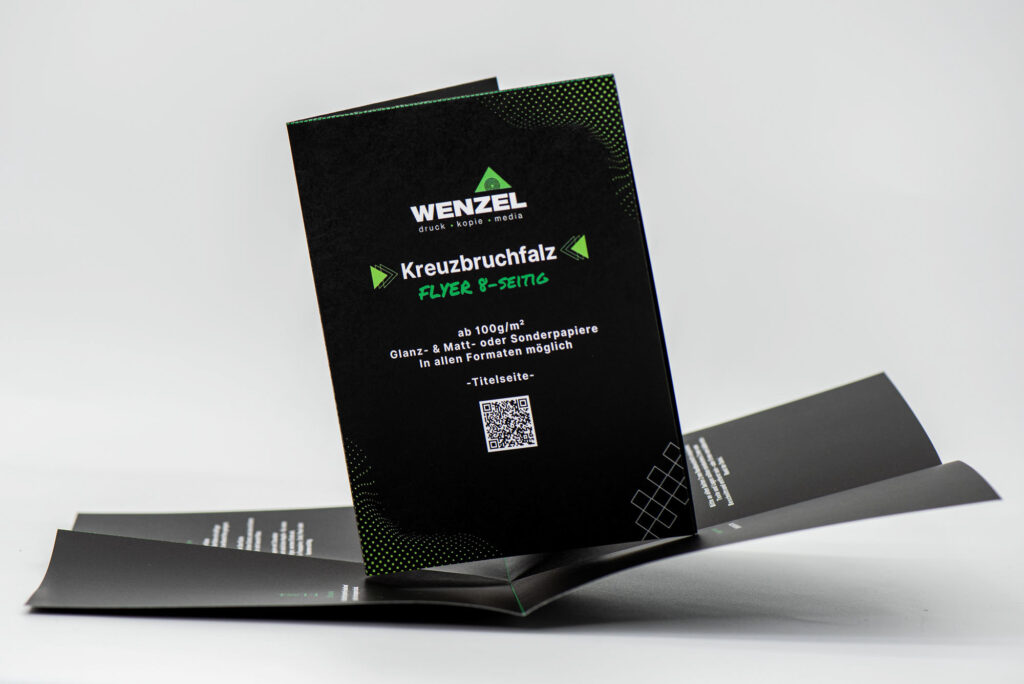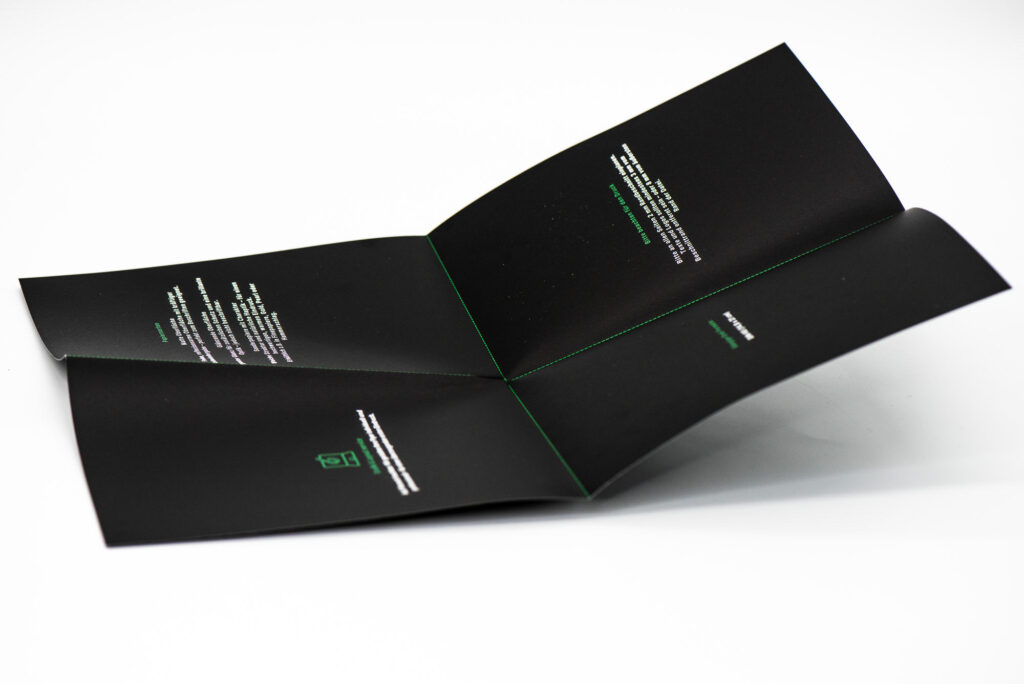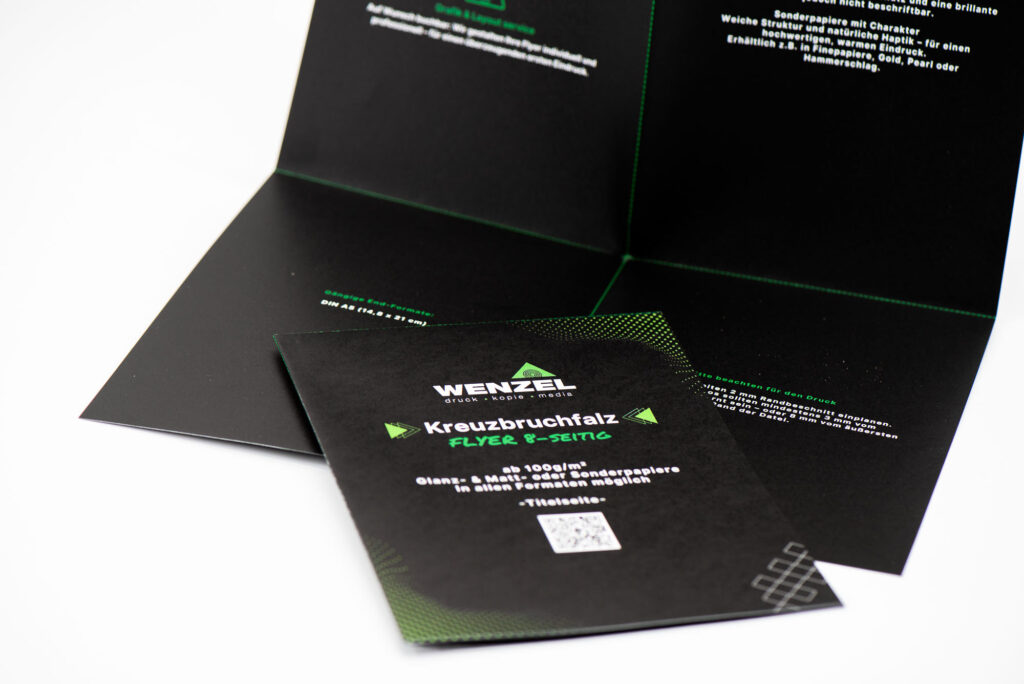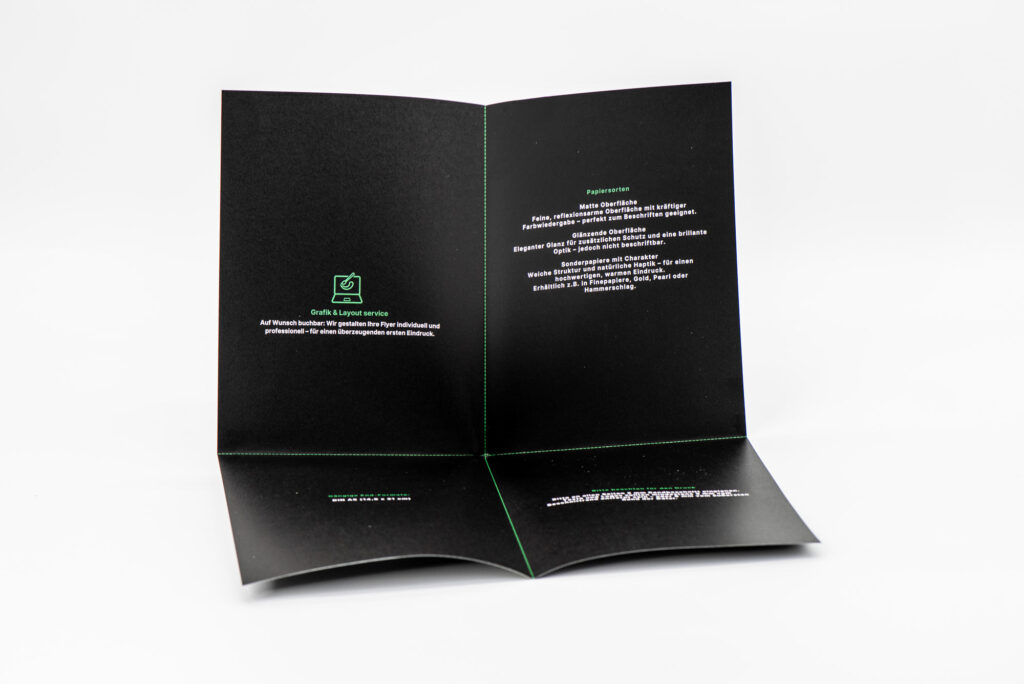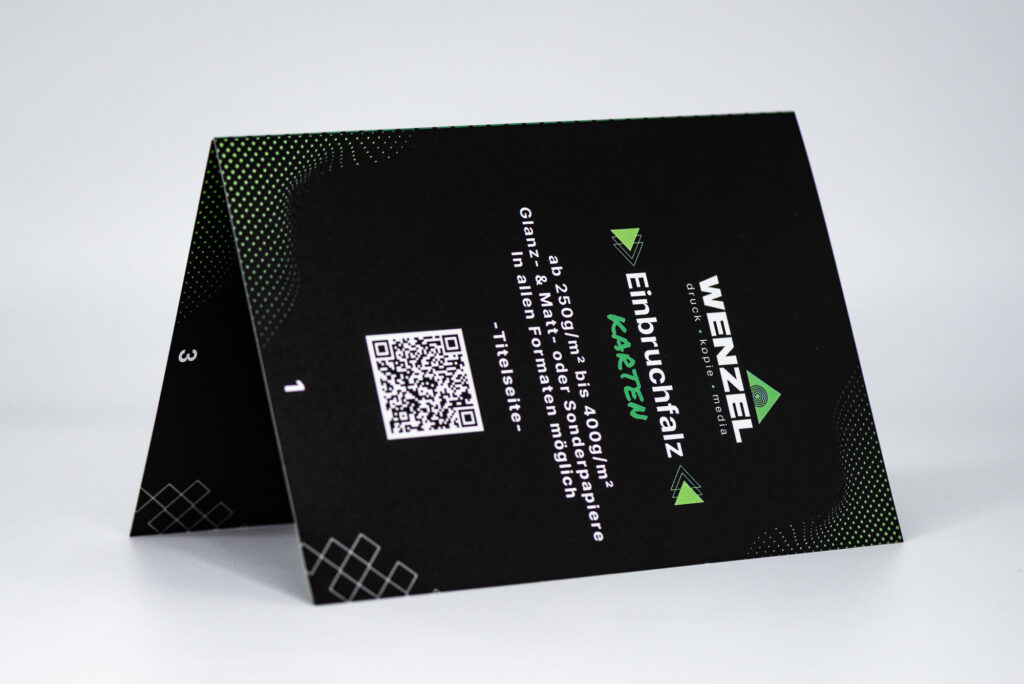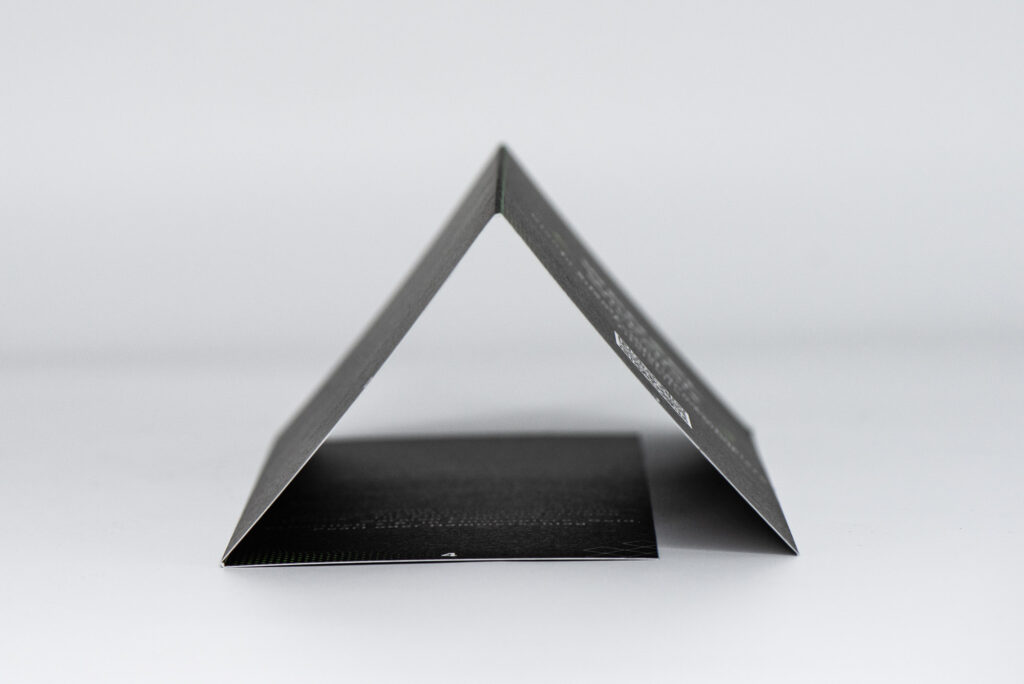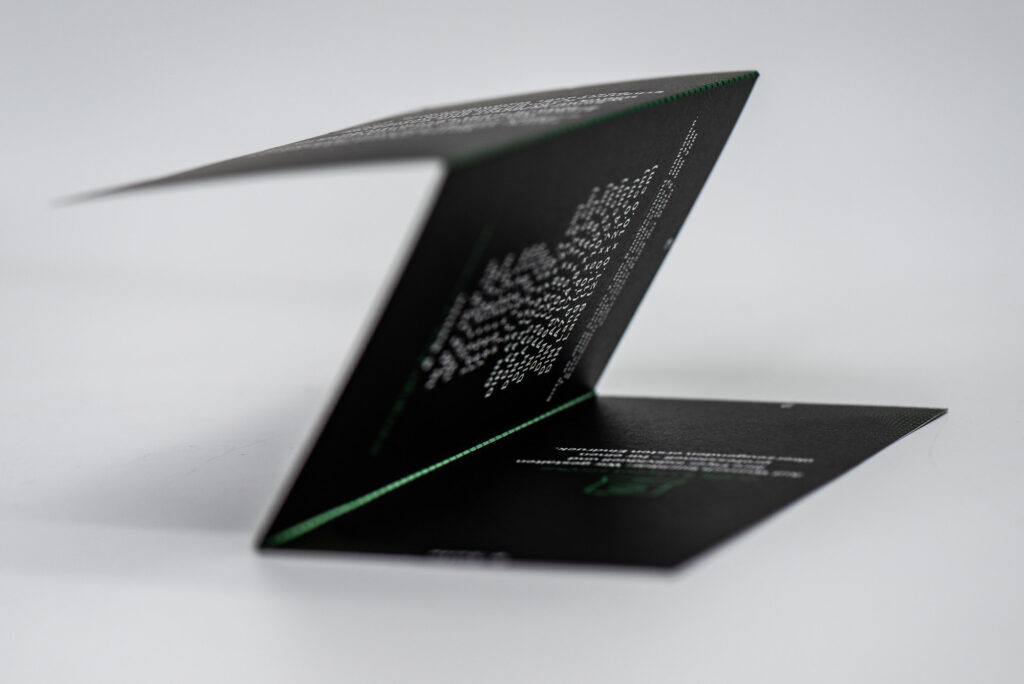Two-break cross-fold flyer
Create & print two-break cross-fold flyers - quickly and professionally
What is a zigzag fold / fanfold?
The Zigzag foldalso as Leporello fold is a special folding technique in which the printed sheet is folded several times in parallel - but with alternating folding directions. This characteristic folding creates an accordion-like structure that forms a continuous, contiguous surface when the sheet is mounted. The name "Leporello" goes back to the Figure from Mozart's opera "Don Giovanni" who carried a long, folded directory with her.
Characteristic properties and structure
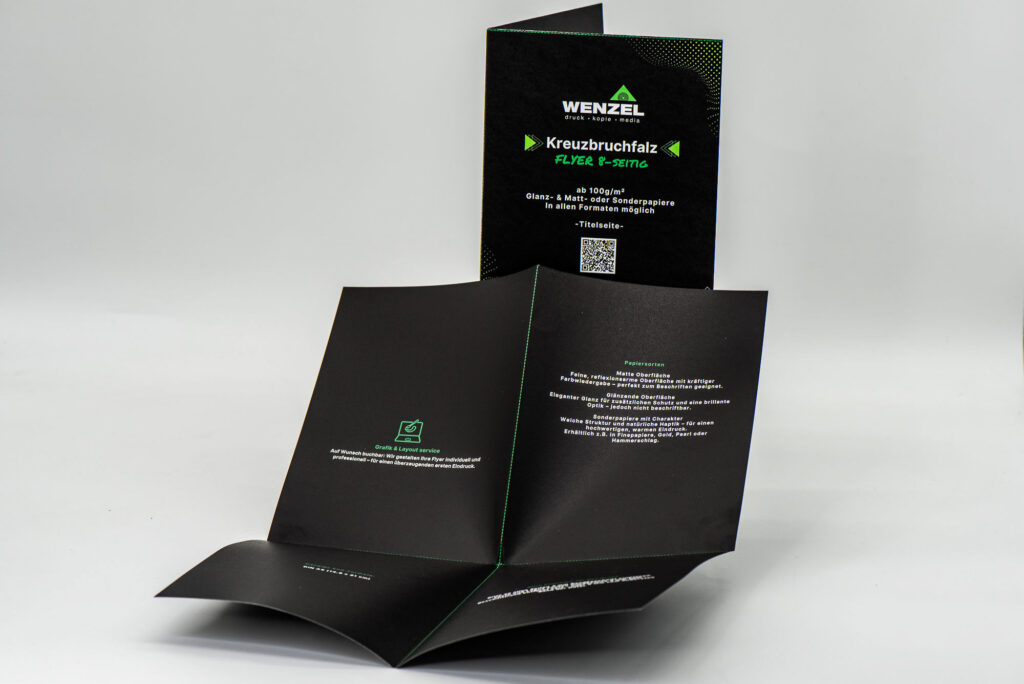
At the Zigzag fold the folds are made alternately to the front and back. This creates a harmonica-like fold that allows the flyer to be folded compactly as well as pulled out completely and viewed as one large, continuous surface. Depending on the number of fold breaks, six to sixteen printable pages are created, with the most common variants comprising between six and ten pages.
Available formats and design options
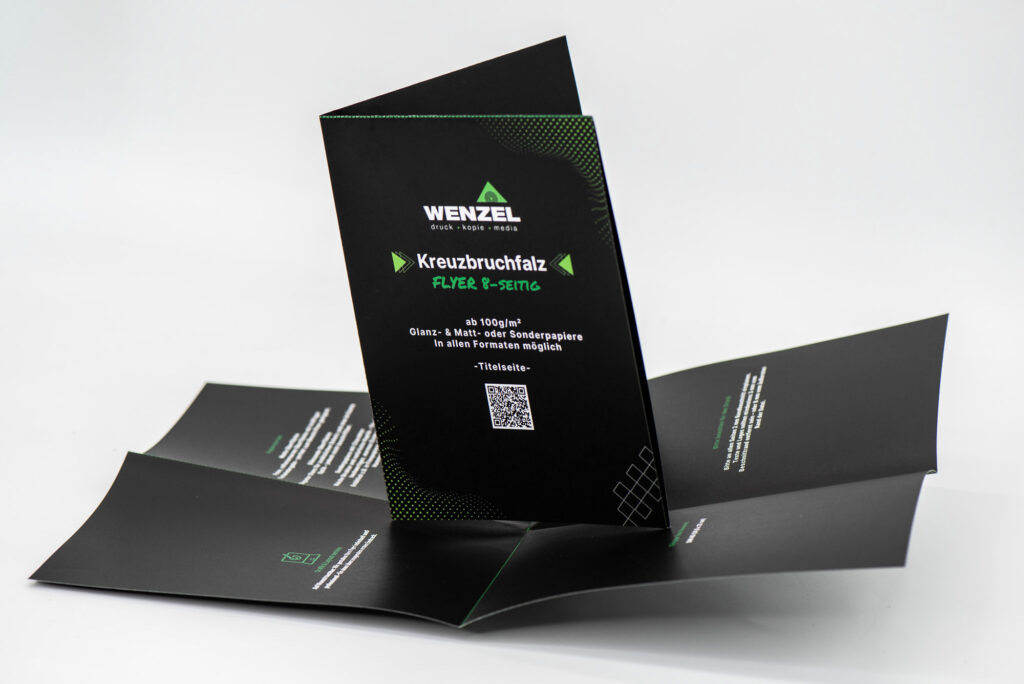
Zigzag fold Flyers are available in various DIN formats from A7 to A3, both in portrait and landscape format. The DIN long format is particularly popular for trade fair stands and events. The landscape format is Zigzag fold is particularly effective, as it shows off the continuous design to its best advantage. Square formats are also available for creative designs as well as individual special formats according to customer requirements.
Areas of application and target groups
The Zigzag fold is perfect for content that needs to be presented both compactly and over a large area. This type of fold is particularly effective for chronological presentations such as timelines or development sequences, panoramic views of landscapes or architectural projects as well as step-by-step instructions and product series presentations. The tourism industry likes to use this type of fold for panoramic maps and sightseeing tours, while real estate companies use it for project developments. Museums and galleries also appreciate the Leporello fold for exhibition guides and artists' works.
Special benefits and effects
The biggest advantage of the Leporello fold lies in the possibility of continuous design. Images, graphics or text can extend across all pages and create an impressive overall picture when fully extended. These flyers can be viewed in different ways - page by page like a traditional flyer, fully unfolded as a large panoramic display or partially opened for specific sections of information. The unusual folding and the surprise effect when unfolded ensure a high level of attention and memorability for the viewer.
Design tips and layout principles
When designing, it should first be decided whether the focus should be on the overall area as a unit or on individual segments. Continuous elements utilize the special character of the Zigzag fold while important information should remain visible even when folded. Contact details should be on the outside for easy retrieval, and images and graphics can be designed effectively across folded edges. Technically, bleed allowances of three millimetres on all sides and safety margins to the folded edges must be observed.
Paper and printing options
For Zigzag fold Various types of paper are suitable for flyers, with art paper weighing 135 to 170 grams per square meter providing a high-quality look. Natural papers are used for ecological projects, while offset paper enables cost-effective solutions. Finishing options such as dispersion varnish for increased durability, UV varnish for brilliant colors or cellophane wrapping in various designs round off the range.
Production and cost factors
The print run options are very flexible and range from 25 copies for small print runs to 200,000 copies for large projects. The costs are significantly influenced by the print run, although significant volume discounts are granted for higher quantities. Other price-influencing factors are the format and number of pages, paper quality and the finishing options selected. Standard production takes three to five working days, while express services enable delivery within 24 to 48 hours.
Sustainability and environmental aspects
Modern print shops offer various ecological alternatives. FSC-certified Papers from sustainable forestry and recycled papers with environmental certifications are available. In addition, climate-neutral printing through CO2 compensation can be selected, and mineral oil-free printing inks based on vegetable oil round off the environmentally friendly options.
Zigzag fold / fanfold: the impressive presentation expert
The Zigzag fold is the perfect choice for anyone who needs a large, coherent display but still wants to present it in a compact and handy way. The characteristic accordion fold creates impressive panoramic effects that attract the viewer's attention and enthusiasm. Whether for chronological presentations, product series or landscape panoramas - the Leporello fold offers unique design possibilities and gives every content a special effect and memorability.
Two-break cross-fold flyer printing at WENZEL
What is the two-break cross-fold?
The Two-break cross-fold is a special folding technique in which the printed sheet is folded crosswise. The flyer is first folded lengthwise and then crosswise. When unfolded, the two resulting folded edges form the shape of a cross, which gives this type of fold its name.
Characteristics and structure
Number of pages and format
The two-break cross-fold creates 8 pages for designing. When opened up, a flyer is four times the size of the closed format. For example, a DIN A4 cross-fold flyer with the open size of 210 x 297 mm becomes a compact final format of 105 x 148.5 mm.
Available formats
Modern print shops offer two-break cross-fold flyers in various DIN formats:
- DIN A3 to DIN A6
- Square formats from 100 x 100 mm to 210 x 210 mm
- Individual special formats
Areas of application and target groups
Perfectly suited for:
- City maps and site plans - ideal for consistent design
- Food and drink menus for restaurants
- Posters and infographics - make full use of the poster character
- Operating instructions and assembly instructions
- Inserts in magazines - compact mailing
- Event overviews and program previews
- Calendars and chronicles for display
Ideal target groups:
- Event organizers and concert agencies for program overviews
- Seminar houses for event calendars
- Service provider for impressive product presentation
- Restaurants and gastronomy for extensive menus
Special advantages of the two-break cross-fold
Three levels of impact
The cross-fold flyer has three different levels of impact: closed, opened once and fully unfolded. These allow information to be conveyed step by step or the big wow effect when fully unfolded.
Use poster character
The special feature of the two-break cross-fold is its poster character when fully opened. Customers can hang up the flyer, making the content effective for a long time and reaching many people.
Compact handling
Despite the large unfolding area, the flyer remains compact and easy to transport when closed. This makes it ideal for shipping and space-saving storage.
Design and layout tips
Advance planning essential
Experts recommend folding a blank sheet with a cross-fold before the actual layout and roughly dividing up where which content will be placed. A hand-drawn draft should be opened and closed several times to test the concept.
Position important information correctly
Company data and contact information should be placed in easy-to-find locations without folding over
Back of the final format (page four in the layout) is perfect for contact details
The front should contain the motto, company name, time, place and theme
Technical requirements
Bleed specifications and fold lines must be taken into account in the design. Modern print shops provide appropriate templates that contain all the important specifications.
Printing options and variety of materials
Paper selection
Grammages from 80g to 350g picture printing paper
Matt or glossy look depending on the effect
Environmentally friendly papers with a high degree of whiteness or waste paper character
FSC-certified Papers for sustainable printing
Conditions and services
Flexible print runs from 25 to 200,000 units
Banding in packages of 25, 50 or 100 copies
Finishing options such as cellophane wrapping or UV varnish
Perforation variants for separable areas
Maximum space with compact handling
The two-break cross-fold is the ideal solution for extensive content that needs to be both compactly sent and impressively presented. With its 8 design pages and the special poster character when unfolded, it is perfect for continuous layouts and large-scale presentations. The three levels of impact also enable strategic information transfer that generates excitement and interest in the viewer
- Sheet folded once in the middle, results in 4 pages.
- Clear, concise structure for content.
- Ideal for invitations, information, product presentations.
- Example: Invitation to an exclusive opening event
- Compact format, easy to distribute.
- Optionally with finishing
- Two sides are folded to the center, resulting in 6 clearly structured pages.
- Opens like a window or altar.
- Example: Image flyers for real estate or luxury brands
- Compactly closed, effective area unfolded.
- For invitations, image flyers and high-quality offers.
- Multi-folded sheet: pages are wrapped. 6 to 12 pages.
- Ideal for structured, continuous content.
- Example: Product presentation for new cosmetics line
- Compact format, large unfolded.
- Price lists, imagebrochures and events.
- Two folds: Sheet is folded once horizontally & vertically: 6 to 10 pages.
- Ideal for plans, posters, image or infographics.
- Example: City map or event overview
- Compact & handy: large surface area: closed flyer is easy to distribute or send.
FAQs on two-break cross-fold flyers: Trends, foil embossing, formats
What is a two-break cross-fold flyer?
A Two-break cross-fold A flyer is a leaflet that is produced using a special folding technique: The printed sheet is folded both horizontally and vertically - "crosswise". The paper is first folded lengthwise and then crosswise. When unfolded, the two resulting folded edges form the shape of a cross, which gives this type of fold its name. The result is 8 printable pages.
What formats are available for two-break cross-fold flyers?
Modern print shops offer various format options:
- DIN formats: from DIN A7 to DIN A3
- Square formats: from 100 x 100 mm to 210 x 210 mm
- DIN long format
- Customized special formats as required
For example, a DIN A4 cross-fold flyer with an open size of 210 x 297 mm results in a compact final format of 105 x 148.5 mm.
What are two-break cross-fold flyers particularly suitable for?
The Areas of application are diverse and utilize the special poster character:
Frequent applications:
- City maps and site plans - ideal for consistent design
- Food and drink menus for the catering trade
- Posters and infographics - use the big pop-up effect
- Operating instructions and technical drawings
- Inserts in magazines - compact mailing
- Event overviews and program previews
- Hall plans and trade fair plans for events
- Schedule overviews and flow charts
Which target groups mainly use Zweibruch-Kreuzfalz flyers?
The main target groups benefit from the combination of compact format and high information density:
- Tourism & Cities: for city maps and sightseeing overviews
- Organizers & trade fairs: for hall plans and schedule overviews
- Technology companies & agencies: for comparative data and infographics
- Graphic design offices & cultural institutions: for theater programs and club brochures
- Seminar houses and concert agencies: for event calendars
What are the special advantages of the two-break cross-fold?
Three levels of impact
The cross-fold flyer has three different levels of impact: closed, opened once and fully unfolded. These allow information to be conveyed step by step or the big surprise effect when fully unfolded.
Use poster character
The special feature is the poster character when fully opened. Customers can hang up the flyer, making the content effective for a long time and reaching many people.
Compact handling
Despite the large unfolding area (four times the size of the closed format), the flyer remains compact and easy to transport. This makes it ideal for shipping and space-saving storage.
What paper options are available?
There are various paper types and grammages for two-break cross-fold flyers:
Paper types:
- Matt or glossy picture printing paper - for a high-quality look
- Natural paper - for ecological events
- Recycled paper with Blue Angel certification - 100% made from recycled paper
- FSC-certified Papers for sustainable printing
Grammages and finishing:
- Various paper thicknesses available
- Cellophane coating in glossy, matt or soft touch
- UV coating for increased abrasion resistance
How many copies can I have printed?
The support options are very flexible:
- Short runs: from 25 pieces
- Large print runs: up to 200,000 units
- Banding: bundling in packages of 25, 50 or 100 copies

Two-break cross-fold flyer: Variants and possible applications
Create & print two-break cross-fold flyers
Two-break cross-fold flyer are special folded sheets that are produced using a characteristic cross-fold technique and are characterized by their compact size combined with a large information area. This type of fold is also known as Cross fold or Double cross fold and is used particularly in the advertising and information industry.
Definition and origin
Folding technique
The two-fold cross-fold is created by folding the printed sheet twice. The paper is first folded lengthwise and then crosswise - "cross-folded". When fully unfolded, the two resulting folded edges form the characteristic cross shape that gives this type of fold its name.
Number of pages and proportions
The cross-fold creates 8 printable pages. When closed, the size is a quarter of the original printed sheet. When fully unfolded, the flyer is four times the size of the final format and thus develops its characteristic poster character.
Technical specifications
Available formats
Two-break cross-fold flyers are available in various standard formats:
Format | Open dimension (mm) | Closed dimension (mm) |
DIN A3 | 297 × 420 | 148,5 × 210 |
DIN A4 | 210 × 297 | 105 × 148,5 |
DIN A5 | 148 × 210 | 74 × 105 |
DIN A6 | 105 × 148 | 52,5 × 74 |
Square formats from 100 × 100 mm to 210 × 210 mm and individual special formats are also available.
Material options
- Picture printing paper: 90g to 350g, matt or glossy
- Natural papers: different grammages and surface structures
- Recycled paper: FSC-certified or with the Blue Angel label
- Finishing options: Cellophane coating, UV varnish, soft-touch coating
Areas of use and applications
Primary uses
The two-break cross-fold is particularly suitable for information-dense content that needs to be both compactly transported and presented over a large area:
- Cartography: city maps, site plans, hiking maps
- Gastronomy: extensive food and drink menus
- Events and trade fairs: Hall plans, program overviews
- Technical documentation: operating instructions, circuit diagrams
- Marketing: posters, infographics, product overviews
Target groups
Tourism and cities use cross-fold flyers for orientation aids, the event industry for program presentations, technical companies for data sheets and cultural institutions for program booklets.
Design principles
Three levels of impact
The two-break cross-fold offers three successive presentation levels:
1. closed condition: title page and back visible
2. once opened: four pages present themselves as a continuous surface
3. fully unfolded: all eight pages result in a large poster-like display
Layout recommendations
- Important contact information should be visible without unfolding
- Central messages can use the large central area
- Continuous design elements such as maps or diagrams benefit from the contiguous area
- Legibility must be guaranteed in all states
Technical specifications
When designing, bleed allowances of 3 mm and safety margins to the folded edges must be observed. Modern print shops provide appropriate layout templates with all technical specifications.
Production process
Printing technology
Two-break cross-fold flyers are printed using offset printing or Digital printing depending on the print run and quality requirements. For small print runs of less than 500 pieces, the Digital printing while larger print runs benefit from more cost-efficient offset printing.
Folding process
The machine folding process takes place in two stages: first the longitudinal fold, then the cross fold. Modern folding machines ensure precise edges and even proportions.
Quality control
Professional print shops carry out multi-stage quality checks, including color control, folding accuracy and final inspection of the finished products.
Economic aspects
Overlay options
The minimum print run for most providers starts at 25 copies, with large print runs of up to 200,000 copies possible. Unit costs are significantly reduced with larger print runs due to economies of scale.
Cost factors
- Format and paper quality determine the basic costs
- Finishing options increase the price proportionally
- Print run significantly influences the unit price
- Delivery time can lead to surcharges for rush orders
Delivery options
Standard production times are 3-5 working days, express services enable deliveries within 24-48 hours. Most providers offer free shipping from certain minimum order values.
Environmental aspects and sustainability
Ecological options
Modern print shops offer various environmentally friendly alternatives:
FSC-certified Papers from sustainable forestry
- Recycled papers with Blue Angel certification (DE-UZ 14a)
- Climate-neutral printing through CO2 compensation
- Mineral oil-free printing inks based on vegetable oil
Resource efficiency
The two-break cross-fold maximizes the information density per square centimetre of paper and at the same time minimizes transport costs thanks to the compact final format.
Technological developments
Digital integration
Modern cross-fold flyers can be equipped with QR codes and NFC tags that lead to digital content. Augmented reality elements expand the possibilities for conveying information.
Finishing innovations
New finishing techniques such as soft-touch coatings, textured coatings and embossing effects increase the tactile value and attention-grabbing quality of the flyers.
Automation
Digital print workflows enable ever smaller print runs at economical prices and significantly shorten production times.
Market development
The demand for cross-fold flyers remains high despite Digitization stable, as they offer a unique combination of compactness and scope of information. They are a proven medium for complex information, particularly in the event and tourism industry.
Hybrid concepts, which combine printed flyers with digital elements, represent the current direction of development and considerably expand the possible applications.
Not found the right product?
Contact our customer advisory service!
per Contact form
or by e-mail:
info@wenzel-muc.de

